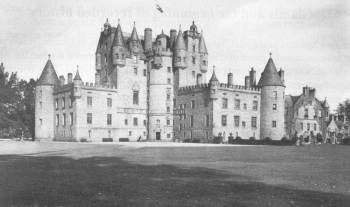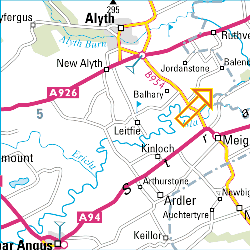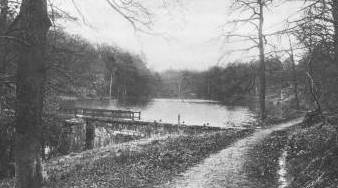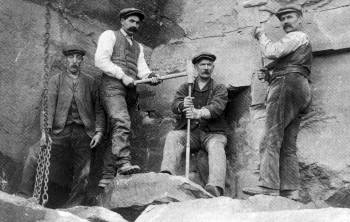
The history of the village of Glamis (or Glammiss as it was known in the 1700s) really should start with a history of Glamis Castle - shown above in a 1900 picture. Glamis was a royal hunting lodge as early as the 11th century. The construction of a castle began in the 15th century when King Robert II gave the lands to Sir John Lyon, his son-in-law. Subsequently, the land owners became known as Lord Glamis. After 1677, Lyon's descendents became known as the Earls of Strathmore and Kinghome. John Lyon, the 9th Earl of Strathmore (1737-1776) married Mary Bowes, a Yorkshire heiress and the family surname became Bowes-Lyon. A century and a half later, Lady Elizabeth Bowes-Lyon was born in London in 1900 but was brought up at Glamis Castle. She later married the Duke of York in 1923, who become King George VI in 1936. Her second daughter, Margaret, was born at Glamis Castle.


Glamis village is located in the Strathmore Valley - a wide, fertile valley starting near Perth and running north-east all the way to the North Sea at Stonehaven south of Aberdeen. Glamis is about 5 miles north-east of Meigle (see maps above). The valley is known for its fertility. Reverend James Lyon, the author of the parish's entry in the Statistical Accounts (1791-99), wrote that the soil was good, well cultivated, and produced plentiful crops. However, he noted that this wasn't always the case. About 60 years ago, the people were funk in sloth and indolence; but a variety of causes have concurred to call forth their vigour and to rouse them into action. Lyon went on to mention that some of the farms were extensive which we can interpret as a sign that the lowland clearances were in progress. Lyon also mentioned that the discovery of marle in the area had had a beneficial impact. Marle is a grayish flaggy stone somewhat similar to slate, and containing a large number of fossil fish. It was valuable as a fertilizer because it contained carbonate of lime. In 1795, the population of the parish was about 2000 people.


At some point during the Industrial Revolution, the linen industry began to occupy a very prominent position in the village. An industrial area developed next to the Glamis Burn to the south-east. A series of weirs and water ducts were constructed along the length of the river. This provided water, and waterpower to wheels and for all of the milling activity (e.g., flax mill) in the area. (A little dam is in the foreground of the picture, above left.) Lyon also pointed out in his accounts that there was a freestone quarry near the village. The quarry's stones were very durable and excellent for building and for millstones. Also, there was an abundance of fine gray slate quarries in the area. Above right - a 1900 picture of men working in one of the quarries.
After the 9th Earl of Strathmore (1737-1776) married Mary Bowes, he began to bring the Strathmore estate back to its former glory. (A previous Earl had backed the wrong side in one of the earlier rebellions and this had nearly bankrupt the Strathmores.) The fact that Mary Bowes was an heiress worth 1,040,000 Scottish pounds might have had something to do with the decision to marry her - but that may be my cynicism showing through. (At the time, a farm labourer earned 8 or 9 Scottish pounds per year. In today's terms, if the average employee earned $50,000 dollars Canadian per year, Mary Bowes' inheritance would be worth $6 trillion dollars Canadian.) So, it would be an understatement to say that she provided the wherewithal for the 9th Earl to get a few odd jobs done around the old hovel. To his credit, the Earl was responsible for much of the development of what is now the present Glamis village.
Sources
Various web sites, including
Glamis and Strathmore website (http://www.glamisweb.com/index.htm)
Statistical Accounts of Scotland, 1791-99. (http://edina.ac.uk/stat-acc-scot/)